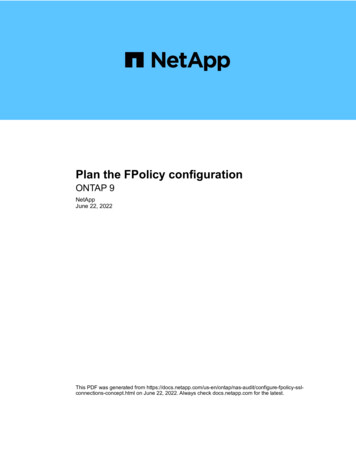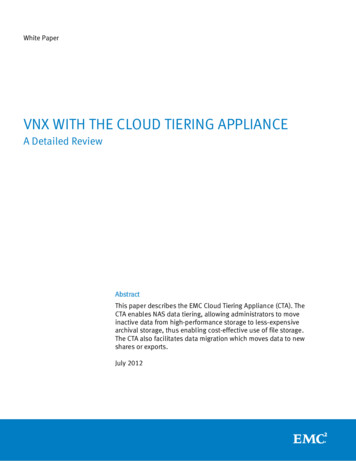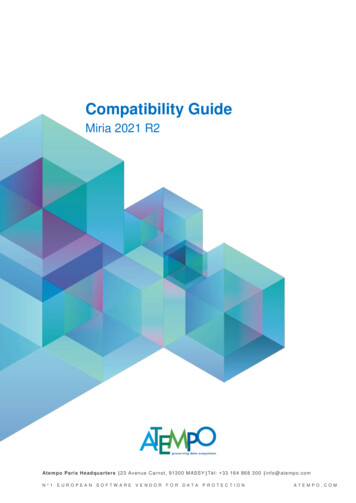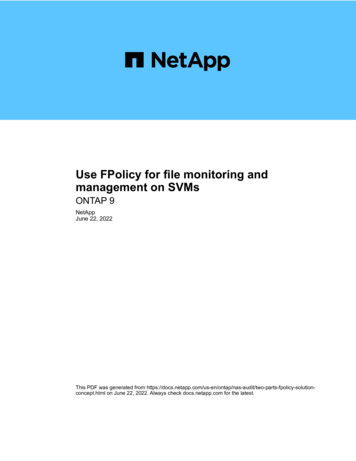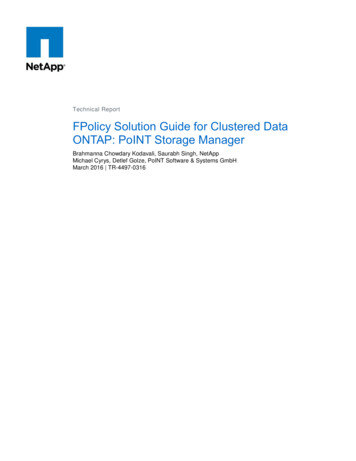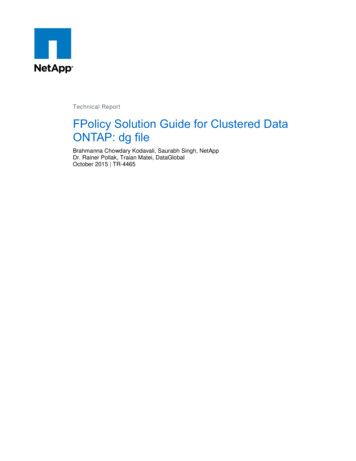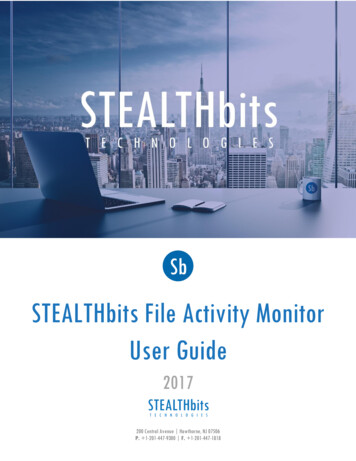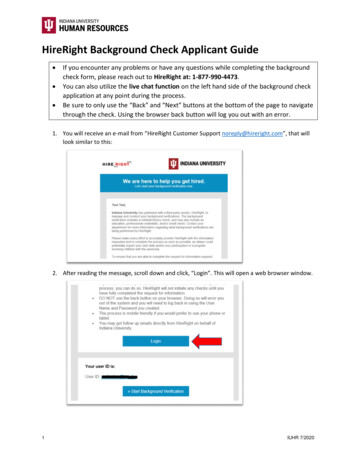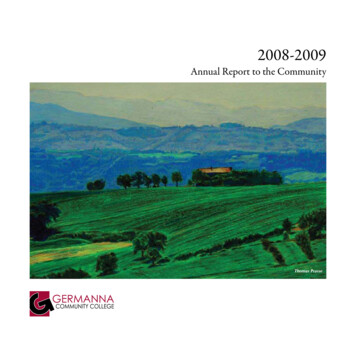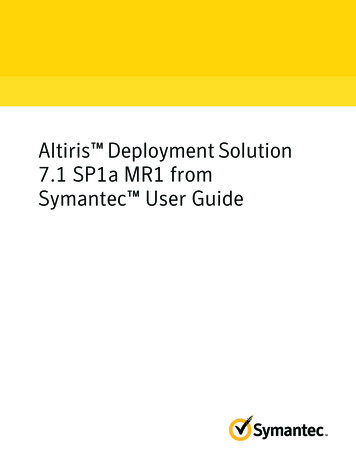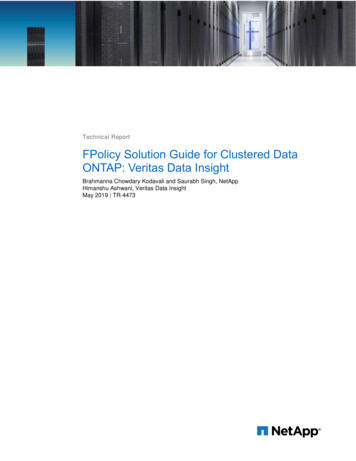
Transcription
Technical ReportFPolicy Solution Guide for Clustered DataONTAP: Veritas Data InsightBrahmanna Chowdary Kodavali and Saurabh Singh, NetAppHimanshu Ashwani, Veritas Data InsightMay 2019 TR-4473
TABLE OF CONTENTS123456Introduction . 41.1Audience .41.2Purpose and Scope .4FPolicy Overview . 42.1Role of Clustered Data ONTAP Components in FPolicy Configuration .52.2How FPolicy Works with External FPolicy Servers .5FPolicy Solution Architecture . 63.1FPolicy Components in Clustered Data ONTAP .63.2FPolicy Application Software: Veritas Data Insight .7Installing and Configuring Veritas Data Insight . 74.1Veritas Data Insight Software Requirements and Installation .74.2Prerequisites for Configuring Clustered Data ONTAP File Servers .74.3Adding Storage Controllers .8FPolicy Configuration in Clustered Data ONTAP . 95.1FPolicy Configuration Workflow .95.2Create FPolicy Event .105.3Create FPolicy External Engine .115.4Create FPolicy Policy .125.5Create FPolicy Scope .125.6Enable FPolicy Policy .13NetApp Clustered Data ONTAP Best Practices . 136.1Policy Configuration .136.2Network Configuration .136.3Hardware Configuration .136.4Multiple-Policy Configuration.146.5Managing FPolicy Workflow and Dependency on Other Technologies .146.6Sizing Considerations .147Veritas Data Insight Best Practices . 148Troubleshooting Common Problems . 1428.1Problem: FPolicy Server Is Disconnected .148.2Problem: FPolicy Server Does Not Connect .158.3Problem: External Engine Is Not Native for Policy .16FPolicy Solution Guide for Clustered Data ONTAP: Veritas Data Insight 2019 NetApp, Inc. All rights reserved.
8.49Problem: Notifications Are Not Received for File Operations on Volume, Share, and Export .16Performance Monitoring . 169.1Collect and Display FPolicy Counters .169.2Counters to Be Monitored .17Where to Find Additional Information . 17NetApp . 17Veritas Data Insigh: . 17Version History . 18LIST OF TABLESTable 1) Credentials for configuring NetApp Data ONTAP file servers. .8Table 2) FPolicy event options. .11Table 3) FPolicy external engine options.11Table 4) FPolicy policy options. .12Table 5) FPolicy scope options. .12Table 6) FPolicy counters. .17Table 7) FPolicy server counters. .17LIST OF FIGURESFigure 1) FPolicy solution architecture. .6Figure 2) FPolicy configuration workflow. .103FPolicy Solution Guide for Clustered Data ONTAP: Veritas Data Insight 2019 NetApp, Inc. All rights reserved.
1 IntroductionThe NetApp FPolicy component is a file-access-notification system that enables an administrator tomonitor file access in storage configured for Network File System (NFS) and CIFS. Introduced for thescaled-out architecture in the NetApp clustered Data ONTAP 8.2 operating system, FPolicy enables arich set of use cases working with selected NetApp partners. FPolicy requires all nodes in a cluster to runData ONTAP 8.2 or later. The system supports all SMB versions, including SMB 1.0 (CIFS), SMB 2.0,SMB 2.1, and SMB 3.0. FPolicy also supports major NFS versions, including NFSv3 and NFSv4.0.FPolicy natively supports a simple file-blocking use case that enables administrators to restrict end usersfrom storing unwanted files. For example, an administrator can block the storage of audio and video filesin data centers and thus save precious storage resources. This feature blocks files based only onextension; for more advanced features, partner solutions should be considered.This system enables partners to develop applications that cater to a diverse set of use cases, includingbut not limited to: File screening File-access reporting User and directory quotas Hierarchical storage management and archiving solutions File replication Data governance1.1AudienceThis document is for customers who want to implement FPolicy for clustered Data ONTAP storagesystems that use the CIFS/SMB protocol.1.2Purpose and ScopeThis document explains the FPolicy framework. It also describes the steps required to deploy a fileaccess auditing solution that uses the data-governance software Veritas Data Insight. The scope of thedocument encompasses deployment procedures and best practices for the solution.2 FPolicy OverviewThe Data ONTAP FPolicy framework creates and maintains the FPolicy configuration, monitors file eventsresulting from client access, and sends notifications to external FPolicy servers. Communication betweenthe storage node and the external FPolicy servers is either synchronous or asynchronous. The use ofsynchronous or asynchronous communication depends on whether the FPolicy framework expects anotification response from the FPolicy server.Synchronous notification is suitable for use cases in which Data ONTAP allows or denies client accessbased on the notification response from the FPolicy server. Use cases such as quotas, file screening, filearchiving recall, and replication require synchronous notification.Asynchronous notification is suitable for use cases such as monitoring and auditing file-access activitythat do not require Data ONTAP to take action based on the notification response from the FPolicyserver. In these cases, Data ONTAP does not need to wait for a response from the FPolicy server.4FPolicy Solution Guide for Clustered Data ONTAP: Veritas Data Insight 2019 NetApp, Inc. All rights reserved.
2.1Role of Clustered Data ONTAP Components in FPolicy ConfigurationThe following components play a role in FPolicy configuration: Administrative SVM. The administrative storage virtual machine (SVM, called Vserver in the DataONTAP CLI and GUI) contains the FPolicy management framework. It maintains and manages theinformation about all FPolicy configurations in the cluster. Data SVMs. FPolicy configuration can be defined at the level of the cluster or the SVM. The scopedefines the resources to be monitored in the context of an SVM. It operates only on SVM resources.One SVM configuration cannot monitor and send notifications for the data (shares) belonging toanother SVM. However, FPolicy configurations defined on the administrative SVM can be leveragedin all data SVMs. Data LIFs. FPolicy server connections are made through data logical interfaces (LIFs) that belong tothe data SVM containing the central FPolicy configuration. The data LIFs used for these connectionscan fail over in the same manner as data LIFs used for normal client access.2.2How FPolicy Works with External FPolicy ServersFPolicy runs on every node in the cluster. It is responsible for establishing and maintaining connectionswith external FPolicy servers. As part of its connection management activities, the FPolicy frameworkhandles many management tasks: Controls the flow of file notifications through the correct LIF to the FPolicy server Load-balances notifications to the FPolicy server if multiple FPolicy servers are associated with apolicy Tries to reestablish the connection when a connection to an FPolicy server is broken Sends notifications to FPolicy servers during an authenticated session Establishes a connection with the data LIFs on all nodes participating in the SVMFor synchronous use cases, the FPolicy server accesses data on the SVM through a privileged dataaccess path. Data ONTAP secures this path by combining specific user credentials with the FPolicyserver IP address that was assigned during FPolicy configuration. After FPolicy is enabled, the usercredentials included in the FPolicy configuration are granted the following special privileges in the filesystem: Ability to bypass permission checks when accessing data, enabling the user to avoid checks on filesand directory access Special locking privileges through which Data ONTAP allows the FPolicy server to read, write, ormodify access to any file regardless of existing locksNote: If the FPolicy server creates byte-range locks on the file, existing locks on the file areimmediately removed.Ability to bypass any FPolicy checks so that file access over a privileged data path does not generatean FPolicy notificationFor more information about FPolicy functionality, see the Clustered Data ONTAP 8.3 File AccessManagement Guide for CIFS on the NetApp Support site.5FPolicy Solution Guide for Clustered Data ONTAP: Veritas Data Insight 2019 NetApp, Inc. All rights reserved.
3 FPolicy Solution ArchitectureThe FPolicy solution consists of the clustered Data ONTAP FPolicy framework and the FPolicyapplication Veritas Data Insight. Figure 1 shows the architecture of the solution.Figure 1) FPolicy solution architecture.The FPolicy application software is installed on a server running Windows Server; the FPolicy frameworkexists in clustered Data ONTAP. The FPolicy framework connects to external FPolicy servers. It sendsnotifications for certain file system events to the FPolicy servers when these events occur as a result ofclient access. The external FPolicy servers process the notifications and send responses back to thenode.3.1FPolicy Components in Clustered Data ONTAPThe FPolicy framework in clustered Data ONTAP includes the following components: External engine. This container manages external communication with the FPolicy serverapplication. Events. This container captures information about protocols and file operations monitored for thepolicy. Policy. This primary container associates different constituents of the policy and provides a platformfor policy-management functions such as policy enabling and disabling. Scope. This container defines the storage objects on which the policy acts; examples includevolumes, shares, exports, and file extensions.6FPolicy Solution Guide for Clustered Data ONTAP: Veritas Data Insight 2019 NetApp, Inc. All rights reserved.
3.2FPolicy Application Software: Veritas Data InsightVeritas Data Insight helps organizations improve unstructured data governance to reduce costs and riskthrough actionable intelligence into data ownership, usage, and access controls. The reporting, analytics,and visualization capabilities in Data Insight shine a light on the data by giving organizations anunderstanding of what data exists, how it is being used, who owns it, and who has access to it.In a distributed client-server architecture, a typical Data Insight deployment includes the followingcomponents: Management server. The main component of a Data Insight deployment and the host of theproduct's web interface. Collector worker nodes. Host machines that scan metadata from NAS file systems (CIFS or NFS),from SharePoint site collection hierarchies, and from enterprise box repositories in your environment.They also collect user access events from these sources. Indexer worker nodes. Nodes that store access events and file system metadata that is collectedfrom the storage repositories and periodically uploaded to them. You can choose to have multipleindexers for load-balancing purposes. Self-service portal nodes. Nodes that provide an interface through which custodians of data cantake remedial actions on the data classified by Veritas Data Loss Prevention software.4 Installing and Configuring Veritas Data Insight4.1Veritas Data Insight Software Requirements and InstallationThis document features the FPolicy application for Veritas Data Insight. For information about softwarerequirements and installation for Veritas Data Insight, see the Veritas Data Insight installation guide,which can be downloaded from the Veritas Technical Support site.4.2Prerequisites for Configuring Clustered Data ONTAP File ServersBefore you can begin using Data Insight to monitor NetApp clustered Data ONTAP file servers, you mustverify that the system has the following capabilities: The system enables you to access the Data ONTAP cluster management host from the Data InsightCollector by using the short name or the IP address. The Data Insight Collector host can communicate with port 80 on the Data ONTAP clustermanagement host. It is important to have this communication capability so that the Data ONTAPcluster can be automatically configured for use by Data Insight. If port 80 is not accessible, theadministrators can configure SSL to enable secure discovery and configuration. For more informationabout configuring SSL, see the Veritas Data Insight administration guide. The Data Insight Collector host can communicate with the CIFS server hosted in the Data ONTAPcluster. This communication capability is important for file system metadata scanning. Service accounts are provisioned for use by Data Insight.Table 1 describes the credentials required for configuring NetApp Data ONTAP file servers to use withData Insight.7FPolicy Solution Guide for Clustered Data ONTAP: Veritas Data Insight 2019 NetApp, Inc. All rights reserved.
Table 1) Credentials for configuring NetApp Data ONTAP file servers.Credential TypeCredential PurposeCredential OwnerCluster managementinterfaceRequired during storage controllerconfiguration through the VeritasData Insight management consoleEither one of these users: A NetApp Data ONTAP cluster administrationuser who is a local user on the Data ONTAPcluster A Data ONTAP cluster nonadministrator userwho has specific privilegesRequired for: Discovering shares Enabling FPolicy on the NetAppstorage controllerScannerFor more information, see Preparing a nonadministrator local user on the clustered NetAppfiler.Required for scanning CIFS shares The user in the domain that contains the NetAppfrom the NetApp storage controller storage controllerThis user must belong to either the power users’group or the administrators’ group on theNetApp storage controller. If the credential is notpart of one of these groups, the scanner cannotget share-level access-control lists (ACLs) forshares of this storage controller.Note: You do not need this privilege if you donot want to get the share-level ACLs. In thatcase, you need only the privileges for mountingthe share and scanning the file systemhierarchy.You must have read permission at the sharelevel. In addition, the folder in the share musthave the following file system ACLs: Traverse folder/execute file List folder/read data Read attributes Read extended attributes Read permissions4.3Adding Storage ControllersYou must add the NetApp storage controllers that you want Veritas Data Insight to monitor.To add a storage controller, complete the following steps:1. In the Data Insight console, select Settings Filers to display the list of available storage controllers.2. Click the Add New Filer drop-down menu and select the type of storage controller you want to add.3. Select NetApp Cluster File Server.4. On the Add New NetApp Cluster File Server page, supply the following information:a. Supply the NetApp cluster management host IP or host name in the Cluster Management Hostfield.b. From the list of nodes, select Data Insight Indexer.c.From the list of nodes, select Data Insight Collector.d. Supply the cluster management interface credentials as explained in Table 1.8FPolicy Solution Guide for Clustered Data ONTAP: Veritas Data Insight 2019 NetApp, Inc. All rights reserved.
5. Click Test Credentials. If the test is successful, select the CIFS server discovered from the DataONTAP cluster.6. Select Enable File System Event Monitoring and Enable FPolicy Automatically (Recommended).When you enable FPolicy from the Data Insight console, Data Insight automatically configures thefollowing items on the NetApp storage virtual machines (SVMs, also known as Vservers) in the DataONTAP cluster: Creates an FPolicy with a unique name Creates an FPolicy engine by specifying the server IP address and the server port Creates a CIFS event object7. Select Enable Filer Scanning.8. Supply scanner credentials as explained in Table 1.9. Click Test Credentials. If the test is successful, save the new storage controller.Note:If this is the first clustered Data ONTAP file server, you are prompted to enable theDataInsightFpolicyCmod service. This is an important step that should be completed beforethe storage controller is saved.10. Navigate to Data Insight Servers Data Insight Chosen Collector Services.11. Select DataInsightFpolicyCmod.12. Specify the following details: An FPolicy name of your choice An FPolicy port of your choice (The NetApp storage controller sends audit events to the DataInsight Collector host on this port. Make sure the firewall rules allow communications on this porton the Data Insight collector.) Data Insight Collector IP address (The host name does not work.)13. Click Configure.14. Return to the Add New Filers tab, which should still be open with your earlier details displayed.15. If you have not already saved the storage controller, save it now.5 FPolicy Configuration in Clustered Data ONTAPThis section provides instructions for configuring FPolicy for NetApp file servers running clustered DataONTAP. The FPolicy structure includes the following components: Event. Defines which operations and protocol types FPolicy audits. External engine. Defines the endpoint to which FPolicy sends notification information. Policy. Provides the aggregation of events policy, external engine, and scope. Scope. Defines the volumes, shares, export policies, and file extensions to which the FPolicy policyapplies. It also allows you to include and exclude all relevant filters.Configuration RequirementsThe shares must reside on the volume monitored for CIFS events.5.1FPolicy Configuration WorkflowFigure 2 shows the workflow for creating a resident policy. Before you create a policy, you should createan external engine and an event. After you define a policy, you must associate a scope with it.9FPolicy Solution Guide for Clustered Data ONTAP: Veritas Data Insight 2019 NetApp, Inc. All rights reserved.
After the scope is created, the policy must be enabled with a sequence number. The sequence numberhelps to define the policy’s priority in a multipolicy environment, with 1 having the highest priority and 10having the lowest.Figure 2) FPolicy configuration workflow.Important NoteIf Veritas Data Insight is configured to work with clustered Data ONTAP, it automatically configuresFPolicy on the SVM.Sections 5.2 through 5.6 explain the commands that the application uses in the background toconfigure the different components. These commands are included strictly for reference. Veritas DataInsight recommends choosing the Automatically Enable FPolicy option. Veritas Data Insight does notrecommend making any manual configurations.If necessary, you can use the show commands in each section to compare the Veritas Data Insightautomatic FPolicy configuration.Veritas Data Insight does not currently support NFS monitoring through FPolicy for clustered DataONTAP.5.2Create FPolicy EventTo enable an external application to connect to a NetApp storage device running clustered Data ONTAP,you must configure an FPolicy policy for it. To be able to do so, you must be a user with the vsadmin roleand have a user name that is associated with the NetApp ONTAPI application. The order in which youcreate an FPolicy event is important.To create an FPolicy event by using Transmission Control Protocol (TCP), complete the following steps:1. Connect to the NetApp Data ONTAP management console through Secure Shell.2. To create and verify an FPolicy event object, run the following command:fpolicy policy event create -vserver vserver name -event-name event name -file-operationscreate, create dir, delete, delete dir, read, close, rename,rename dir -protocol cifs –filters first-read, close-withmodification10FPolicy Solution Guide for Clustered Data ONTAP: Veritas Data Insight 2019 NetApp, Inc. All rights reserved.
Table 2 lists the options for the FPolicy event.Table 2) FPolicy event options.OptionDescription-vserverThe name of the Vserver on which you want to create an FPolicy external engine-event-nameThe name of the FPolicy event that you want to create-file-operationsThe file operations for the FPolicy eventPossible values: create, create dir, delete, delete dir, read,close, rename, rename dir-protocolThe name of the protocol for which the event is createdPossible value: cifs-filtersThe filters used with a given file operation for the protocol specified in the-protocol parameterExamples: first-read, close-with-modificationTo view the event object, run the following command:fpolicy policy event show event name –instance5.3Create FPolicy External EngineTo create an FPolicy external engine, run the following command:fpolicy policy external-engine create -vserver vserver name -engine-name engine name –primaryservers ip address of Data Insight fpolicy server -port port used by Data Insight server -extern-enginetype asynchronous –ssl-option no-authTable 3 lists the options for the FPolicy external engine.Table 3) FPolicy external engine options.OptionDescription-vserverThe name of the Vserver on which you want to create an FPolicy external engine-engine-nameThe name of the external engine that you want to create-primary-serversThe IP addresses for the primary FPolicy servers-portThe port number for the FPolicy service-extern-enginetypeThe type of external engine-ssl-optionThe SSL option for external communication with the FPolicy serverPossible values: server-auth. Provides FPolicy server authentication.Note: Only synchronous external engine communication is supported. mutual-auth. Provides both FPolicy server and NetApp authentication.11FPolicy Solution Guide for Clustered Data ONTAP: Veritas Data Insight 2019 NetApp, Inc. All rights reserved.
To view the external engines you created, run the following command:FPolicy policy external-engine show5.4Create FPolicy PolicyImportant NoteIf FPolicy is configured manually on clustered Data ONTAP (which Veritas Data Insight does notrecommend), then you must provide this FPolicy name on the Data Insight configuration console.To create the FPolicy policy, run the following command:fpolicy policy create -vserver vserver name policy-name policy name -events event name -engine engine name -is-mandatory falseTable 4 lists the policy options for FPolicy.Table 4) FPolicy policy options.OptionDescription-vserverThe name of the Vserver on which you want to create an FPolicy external engine-policy-nameThe name of the FPolicy policy that you want to create-eventsA list of events to monitor for the FPolicy policy-engineThe name of the external engine that you want to create-is-mandatoryDetermines whether the FPolicy object is mandatoryTo view the policy you created, run the following command:fpolicy policy show5.5Create FPolicy ScopeTo create the FPolicy scope, run the following command:fpolicy policy scope create -vserver vserver name -policy-name policy name -volumes-to-include "*" export-policies-to-include "*"Table 5 lists the options for the FPolicy scope.Table 5) FPolicy scope options.OptionDescription-vserverThe name of the Vserver on which you want to create an FPolicy external engine-policy-nameThe name of the FPolicy policy that you want to create-volumes-toincludeA comma-separated list of volumes to be monitored-export-policiesto-includeA comma-separated list of export policies for monitoring file access12Note: Wildcards are supported.FPolicy Solution Guide for Clustered Data ONTAP: Veritas Data Insight 2019 NetApp, Inc. All rights reserved.
To view the FPolicy scope you created, run the following command:fpolicy policy scope show -vserver vserver name - policy-name policy name 5.6Enable FPolicy PolicyVeritas Data Insight uses the following command to automatically enable the new FPolicy policy atstartup:fpolicy policy enable -vserver vserver name -policy-name policy name –sequence-number seqno 6 NetApp Clustered Data ONTAP Best PracticesNetApp recommends following FPolicy best practices for server hardware, operating systems, patches,and so forth.6.1Policy ConfigurationConfiguration of FPolicy External Engine for SVMProviding additional security comes with a performance cost. Enabling SSL communication affectsperformance on CIFS.Configuration of FPolicy Events for SVMMonitoring file operations affects the overall user experience. In fact, filtering unwanted file operations onthe storage side improves the overall user experience. NetApp recommends monitoring the minimumnumber of file operations and enabling the maximum number of filters without breaking the use case. TheCIFS home directory environment has a high percentage of getattr, read, write, open, and closeoperations. NetApp recommends using filters for these operations. For a list of recommended filters, seesection 5.2, “Create FPolicy Event.”Configuration of FPolicy Scope for SVMRestrain the scope of
The NetApp FPolicy component is a file-access-notification system that enables an administrator to monitor file access in storage configured for Network File System (NFS) and CIFS. Introduced for the scaled-out architecture in the NetApp clustered Data ONTAP .
